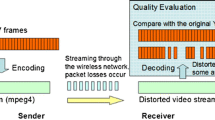Abstract
We are introducing a real-time variable frame rate control scheme capable of optimizing both spatial and temporal video qualities. It traces the motion of incoming video frames and automatically tunes the outgoing frame rate according to the level of jerkiness acceptable by the user. The control scheme was conceived within the framework of mobile communications, which require an optimum use of both the available bandwidth and terminal resources. We have designed and implemented a video transcoding architecture which supports our frame rate control. The transcoder has been developed at the Coritel laboratories, Rome, Italy (Coritel is a research consortium managed by Ericsson Lab, Italy, and the University of Rome La Sapienza), while the visual tests were carried out at the ISCOM laboratory, Italian Communication Ministry, Rome, Italy. The proposed transcoding architecture is compatible with the constraints of real-time communications and it has been extensively tested under a wide range of conditions. We then present a subjective assessment of our solution carried out in a fully equipped professional laboratory. Within this assessment a number of non-expert viewers were asked to express their preference when watching side by side the same video, coded at a variable frame rate and at a fixed frame rate. Results show that in most cases a variable frame rate control based on a dynamic bit/frame allocation scheme might substantially improve video quality perceived by viewers.














Similar content being viewed by others
Notes
Spatial resolution reduction should also be mentioned; however, we do not deal with it in this paper.
MA l n can assume values between 0 and 32. In Fig. 1a the unit of the y-axis is the half-pixel.
As in [13], we set 5 fps as the lowest output frame rate, so (t n − t n−1 ) has a maximum value of 0.2 s. Then J n can be at most 6.4 pixels.
The input frame rate can be easily computed by using two successive RTP Timestamps.
In Carphone the camera is placed in a car, filming a close-up talking head; at frame 180 the camera zooms out, and there are trees entering the background yielding the effect of movement.
The average frame rate is about 17 fps for VFR_0.12.
References
Felice, R., Iacovoni, G., Morsa, S.: Quality-temporal transcoder driven by the Jerkiness. In: Proceedings of the IEEE ICME, pp. 1452–1455 (2005)
Baroncini, V., Ciavatta, D., Felice, R., Gaudino, G., Iacovoni, G., Ubaldi, F.: Variable frame rate video for mobile devices. In: Proceedings of the Mobimedia, pp. 177–182 (2006)
Xin, J., Lin, C.-W., Sun, M.-T.: Digital video transcoding. Proc. IEEE 93(1), 84–97 (2005). doi:10.1109/JPROC.2004.839620
Shen, B., Tan, W.-T., Huve, F.: Dynamic video transcoding in mobile environments. IEEE MultiMed. 15(1), 42–51 (2008). doi:10.1109/MMUL.2008.5
Faria, G., Henriksson, J.A., Stare, E., Talmola, P.: DVB-H: digital broadcast services to handheld devices. Proc. IEEE 94(1), 194–209 (2006). doi:10.1109/JPROC.2005.861011
Narayanan, S.R., Braun, D., Buford, J., Fish, R.S., Gelman, A.D., Kaplan, A., Khandelwal, R., Shim, E., Yu, H.: Peer-to-peer streaming for networked consumer electronics. IEEE Commun. Mag. 45(6), 124–131 (2007). doi:10.1109/MCOM.2007.374436
Reed, E.C., Member, J.S.: Lim, Optimal multidimensional bit-rate control for video communication. IEEE Trans. Image Process. 11(8), 873–885 (2002). doi:10.1109/TIP.2002.801122
Yin, P., Vetro, A., Xia, M.: Rate-distortion models for video transcoding. In: Proceedings of the SPIE, pp. 479–488 (2003)
Kuo, T.-Y.: Variable Frame Skipping Scheme Based on Estimated Quality of Non-coded Frames at Decoder for Real-Time Video Coding. IEICE Trans. Inf. Syst. E. 88-D(12), 2849–2856 (2005)
Correia, P.F., Silva, V.M., Amado Assunção, P.: A method for improving the quality of mobile video under hard transcoding conditions, IEEE International Conference on Communications, pp. 928–932 (2003)
Wang, Y., Chang, S.-F., Loui, A.C.: Subjective preference of spatio-temporal rate in video adaptation using multi-dimensional scalable coding. In: Proceedings of the IEEE ICME, pp. 1719–1722 (2004)
Yadavalli, G., Masry, M., Hemami, S.S.: Frame rate preferences in low bit rate video. In: Proceedings of IEEE ICIP, pp. 441–444 (2003)
Brun, P., Hauske, G., Stockhammer, T.: Subjective assessment of H.264/AVC video for low-bit rate multimedia messaging services. In: Proceedings of the IEEE ICIP, pp. 1145–1148 (2004)
G. Hauske, T. Stockhammer, R. Hofmaier, Subjective image quality for low-rate and low-resolution video sequences. In: Proceedings of the MoMuC (2003)
Önür, Ö.D., Alatan, A.A.: Video adaptation for transmission channel by utility modelling. In: Proceedings of the IEEE ICME, pp. 1400–1403 (2005)
Fung, K.-T., Chan, Y.-L., Siu, W.C.: New architecture for dynamic frame-skipping transcoder. IEEE Trans. Image Process. 11(8), 886–900 (2002). doi:10.1109/TIP.2002.800890
Shu, H., Chau, L.-P.: Frame Skipping Transcoding with Motion Change Consideration. In: Proceedings of IEEE ISCAS, pp. 773–776 (2004)
Shu, H., Chau, L.-P.: Variable frame rate transcoding considering motion information. In: Proceedings of IEEE ISCAS, pp. 2144 – 2147 (2005)
Song, H., Jay Kuo, C.-C.: Rate control for low-bit-rate video via variable-encoding frame rates. IEEE Trans. Circuits Syst. Video Technol. 11(4), 512–521 (2001). doi:10.1109/76.915357
IETF RFC3261 SIP: session initiation protocol: Available at: http://www.ietf.org/rfc/rfc3261.txt
Yang, K.-C., Guest, C.C., El-Maleh, K., Das, P.K.: Perceptual Temporal Quality Metric for Compressed Video. IEEE Trans. Multimed. 9(7), 1528–1535 (2007). doi:10.1109/TMM.2007.906576
Chen, Z., Ngan, K.N.: Recent advances in rate control for video coding, Signal Process. Image Commun. 22(1), 19–38 (2007). doi:10.1016/j.image.2006.11.002
ITU-T Recommendation P.910 Subjective video quality assessment methods for multimedia applications. Available at: http://www.itu.int/rec/T-REC-P.910/en
ITU-T Recommendation P.911 Subjective audiovisual quality assessment methods for multimedia applications. Available at: http://www.itu.int/rec/T-REC-P.911/en
ITU-R Recommendation BT: 500 Methodology for the subjective assessment of the quality of television pictures. Available at: http://www.itu.int/rec/R-REC-BT.500/en
Bartoli, I., Iacovoni, G., Ubaldi, F.: A synchronization control scheme for videoconferencing services. J. Multimed. 2(4), 1–9 (2007)
Author information
Authors and Affiliations
Corresponding author
Rights and permissions
About this article
Cite this article
Baroncini, V., Felice, R. & Iacovoni, G. Variable frame rate control jerkiness-driven. J Real-Time Image Proc 4, 167–179 (2009). https://doi.org/10.1007/s11554-008-0103-z
Received:
Accepted:
Published:
Issue Date:
DOI: https://doi.org/10.1007/s11554-008-0103-z




